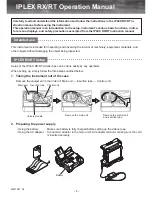
Basic Instructions
CP300 Owner’s Manual
19
Introduction
REC
STOP
PLAY/PAUSE
SYNCHRO START
1
2
3-16
TRACK
PERFORMANCE
PERFORM.FILE
ZONE 1
ZONE 2
ZONE 3
ZONE 4
MASTER
MASTER EDIT
GRAND
PIANO 1
GRAND
PIANO 2
MONO
PIANO
E. PIANO 1
E. PIANO 2
E. PIANO 3
CLAVI.
VIBES
ORGAN 1
ORGAN 2
HARPSI.
STRINGS
CHOIR/PAD
GUITAR
BASS
XG
1
2
3
4
5
6
7
8
9
10
11
12
13
14
15
16
Recording Your Performance and Playing It Back
Recording and playing back your performance is exceptionally easy. The
CP-300 allows you to record up to sixteen independent parts, letting you
record the left- and right-hand parts separately—and lets you build up a
complete, multi-instrument Song by recording each part one-by-one.
• Recording Your Performance (page 42)
• Other Recording Techniques (page 46)
• Handling Song Files (page 81)
• Playing Back Songs (page 49)
Terminology
On the CP300, performance data is called a “
Song
.” This includes
demonstration tunes and piano preset tunes.
Using the Performance Functions
The useful Performance functions enable you to store and recall the entire
CP300 settings all together. These include the Dual/Split settings, Voice
and effect parameters, MIDI transmit/receive channel settings and Master
Edit settings. If you have any original Voices you’ve created, you can save
these to a Performance as well.
• Using the Performance Functions (page 73)
• Selecting a Performance (page 40)
• Performance Parameters (page 74)
• Handling Performance Files (page 76)
Using as a Master Keyboard
The Master mode of the instrument enables you to control up to four external tone
generators (or four separate instrument parts on one multi-timbral tone generator).
This effectively lets you play four different MIDI instruments at one time. Once you’ve
created your custom Master settings, you can save them to a Performance as well.
Содержание CP300
Страница 1: ...OWNER S MANUAL STAGE PIANO EN ...
















































